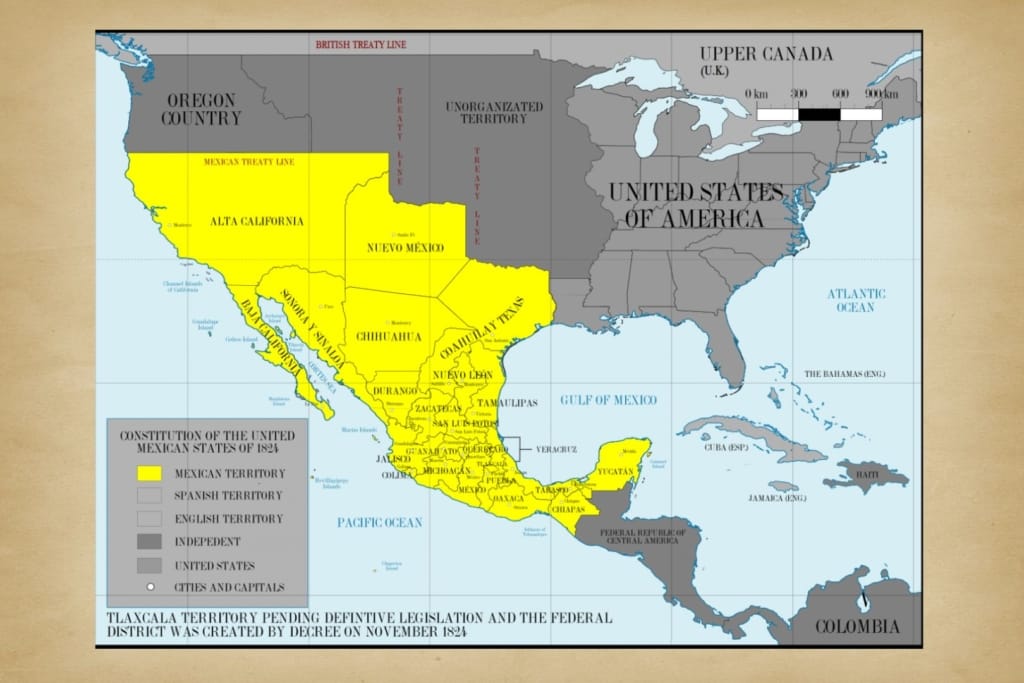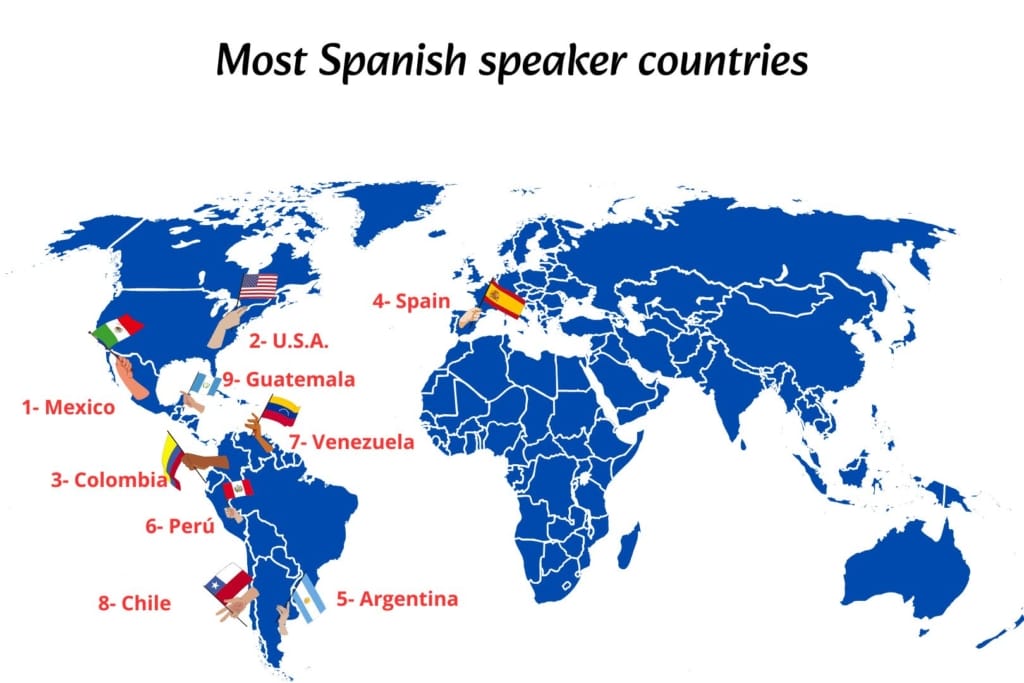
It would be logical to assume that Spain has the highest number of Spanish speakers in the world, right? Given its history, one might think Spain dominates the global use of the language. However, you may be surprised to learn that Spain is far from being the country with the most Spanish speakers. And what will shock you even more is who holds second place—none other than… the United States!
Yes, you read that correctly. The U.S. is home to the second-largest population of Spanish speakers in the world. But how can a predominantly English-speaking country rank so high in Spanish-speaking residents? There are countless reasons, and today, we’ll explore them all. Some historical facts might surprise you, while others will make perfect sense. Plus, you’ll see how Spanish speakers form the largest linguistic “minority” in the U.S.
Let’s take a journey through one of the most fascinating cultural and linguistic phenomena of modern history. But first… we know what you’re wondering: Which countries have the most Spanish speakers in the world? Stay with us because the facts might surprise you.
Why isn’t Spain the country with the most Spanish speakers?
The fact that Spain doesn’t hold the top spot for the most Spanish speakers shouldn’t come as a shock. Similarly, it’s not surprising that England isn’t home to the largest number of English speakers. Or that Portuguese is more widely spoken outside of Portugal. Or that French isn’t spoken the most in France.
Why? Colonial history holds the answer.
The world as a game board
Today, we see Europe as a peaceful and inclusive continent, but history tells a different story. From the 16th century to well into the 20th century, European nations competed for global dominance. While it sounds barbaric today (because it was!), before World War I, colonial expansion was practically a status symbol for European powers. In other words, a country’s success was often measured by how much land it could conquer.
As a result, the strongest military and economic powers expanded their territories as if they were playing a game of Monopoly. Nations like England, France, Portugal, and Spain fought to claim land across the Americas, Africa, Asia, and Oceania.
From a linguistic perspective, this global conquest is a major reason why Indo-European languages are so widespread today. It also explains why former European colonies adopted their colonizers’ languages as their own.
Why are there so many Spanish speakers across the Americas?
Spain, one of the dominant colonial powers, conquered nearly the entire American continent—from what is now Oregon to Patagonia. Naturally, in a vast territory that was hundreds of times larger than Spain, the Spanish-speaking population grew exponentially.
However, one key factor that significantly influenced the spread of Spanish was Spain’s unique approach to colonization. Unlike other empires, where colonizers remained separate from the native population, Spain fully integrated into the societies it ruled.
The Spanish settlers intermarried with Indigenous peoples and African slaves, creating a richly diverse population. This process, known as “mestizaje” (racial and cultural mixing), extended beyond genetics—it also shaped culture and language.
The rise of “American Spanish”
As Spanish-speaking populations grew, so did the reach of the language itself. Over time, Spanish became the dominant language in most Spanish-ruled territories. In many cases, it even absorbed or replaced Indigenous languages.
Meanwhile, European Spanish and Latin American Spanish began to diverge linguistically, developing regional differences. Despite these variations, Spanish remained a single, unified language, unlike some former French and Dutch colonies, where Indigenous and African influences created entirely new languages—such as Haitian Creole or Papiamento.
This flexibility and adaptability allowed Spanish to thrive across Latin America, solidifying its position as one of the world’s most spoken languages.
But that still leaves one question…

Why are there so many Spanish speakers in the U.S.?
This is a fascinating question for language enthusiasts. It’s intriguing because we can witness—almost in real-time—a process that typically takes thousands of years to develop. In less than a century, the linguistic landscape of the United States has changed dramatically.
The U.S. is not a homogeneous country in any sense. The original 13 colonies in the northeast expanded into the 50 states we know today. Throughout this process, the U.S. purchased or conquered lands that once belonged to Mexico, France, Spain, and even Russia.
As a result, the modern U.S. is built upon the cultural heritage of dozens of peoples, with immigrants playing a crucial role in its formation. That’s why the U.S. is often referred to as “a nation of immigrants.”
The Mexican and Spanish past of the U.S. southwest
A large portion of what is now the Midwest and Southwest of the U.S. was Mexican territory until just a couple of centuries ago. These lands, either ceded or lost by Mexico, eventually became more than half of the U.S. geographically.
The present-day states of Texas, New Mexico, Arizona, Utah, California, Nevada, Florida, and Colorado were once Spanish colonies. After Mexico gained independence, these territories became part of Mexico before being incorporated into the United States. Because of this, many people in these areas have Spanish-speaking ancestors.
In many border regions with Mexico, a unique linguistic fusion has emerged. In an area spanning hundreds of thousands of kilometers, Spanish and English speakers have blended their languages in remarkable ways. Moreover, in several U.S. cities, Spanish and Mexican heritage remain deeply embedded in their culture.
The modern migration of Spanish speakers
It makes sense that Spanish is widely spoken in places like Texas or California. But why are there so many Spanish speakers in northern cities like Chicago or New York? The answer lies in one of the most significant social phenomena in human history: Migration.
Due to its geographic, economic, and social proximity to Latin America, the U.S. has become the primary destination for many Latino migrants. In fact, some U.S. cities have Latino communities that outnumber all other demographic groups.
Additionally, Spanish has become a key language in the U.S. education system. It is now the most studied foreign language in schools and universities, and many English speakers can communicate in Spanish fluently.
This trend accelerated in the late 20th century and has continued growing to this day. Today, Spanish speakers form the largest linguistic group in the U.S. after English speakers.
Spanish leads the list of second languages spoken in the U.S., and it’s the most popular language choice among students. Given these numbers, the real question is: How many Spanish speakers are there in the U.S.?
When you see the top 10 Spanish-speaking countries, you’ll be amazed.

The 10 countries with the most Spanish speakers in the world
As we have seen, Spanish is considered the fastest-growing language worldwide. While Spanish speakers don’t yet outnumber English or Chinese speakers, the trends are promising. Currently, these are the top 10 countries with the most Spanish speakers:
1. Mexico
Undoubtedly, Mexico has the largest number of Spanish speakers on the planet. More than 130 million people speak Spanish as their primary or only language. According to its constitution, Spanish is the country’s official language. However, the Mexican government recognizes other languages, such as Nahuatl and 67 additional indigenous languages, as co-official.
2. United States
This statistic surprises many: the United States has an impressive 56 million Spanish speakers. Although the U.S. Constitution does not establish an official language, English is the dominant language nationwide.
In regions like the Southwest, Spanish and English coexist naturally, with many residents fluent in both languages. In cities such as Miami or San Diego, the number of Spanish speakers rivals that of English speakers.
3. Colombia
Colombia ranks third in the world in terms of Spanish speakers, with over 51 million people speaking the language. Spanish is officially recognized by the Colombian Constitution, although some indigenous languages—such as Wayuu or Palenquero—still exist. However, Spanish remains the dominant language across the country.
4. Spain
Despite being the birthplace of Spanish, Spain ranks fourth in the number of Spanish speakers worldwide, with just over 46 million speakers. However, Spanish is not the only official language in Spain.
The country is home to other co-official regional languages, including Catalan, Basque, Galician, Aragonese, and Valencian. These languages are widely spoken and hold official status in different regions.
5. Argentina
Argentina ranks fifth, closely following Spain in terms of Spanish-speaking population. Around 41 million people in Argentina speak Spanish.
Other languages, such as Guarani and Quechua, exist in the country but are not widely spoken or considered official vehicular languages. Additionally, due to immigration, Argentina has a significant number of English, French, Portuguese, and Italian speakers. The Italian community in Argentina is the largest outside Italy.
6. Peru
Peru is home to more than 33.5 million Spanish speakers. Interestingly, while Spanish is the dominant language in all social and economic spheres, the country is linguistically diverse.
Peru officially recognizes Quechua and Aymara as co-official languages in certain regions. In total, Peru is home to more than 20 different languages spoken by various indigenous communities.
7. Venezuela
Venezuela ranks seventh, with over 32 million people speaking Spanish as their first language. Although some indigenous languages are officially recognized, Spanish is the only official language used nationwide.
An interesting fact is that Venezuelan migration has exceeded 8 million people, with many settling in Latin American countries, Spain, and the United States.
8. Chile
Chile ranks eighth among the world’s largest Spanish-speaking populations. In Chile, Spanish is the official language, used in all aspects of society.
However, in some regions, Mapuche is recognized as a secondary language, due to the concentration of indigenous communities. Chile has a Spanish-speaking population of nearly 19 million people.
9. Guatemala
Guatemala has over 17 million Spanish speakers. While Spanish is the primary language, it coexists with several indigenous languages.
The Guatemalan government officially recognizes over 22 languages originating from Mayan, Garífuna, and Xinka cultures.
10. Ecuador
Last but not least, Ecuador ranks tenth, with more than 16 million Spanish speakers. In Ecuador, Spanish is the official language, but the constitution also recognizes Quechua, Aymara, and 14 other indigenous languages.
Spanish: A global language on the rise
Spanish is either the official language or the dominant language in over 21 countries worldwide. It is spoken across two-thirds of the American continent and even in countries like the Philippines and Equatorial Guinea.
Even in non-Spanish-speaking nations, interest in learning Spanish continues to grow. Thanks to popular culture and globalization, Spanish is becoming more accessible than ever.
Learning Spanish has never been easier, thanks to modern technology. Talkao Translation apps make it simple to learn and translate Spanish instantly.
With mobile apps available for any device, you can access tools like Talkao Translate to translate over 125 languages into Spanish—quickly and effortlessly. With English-Spanish translators, becoming a Spanish speaker is now, quite literally… just a tap away!










Newsletter